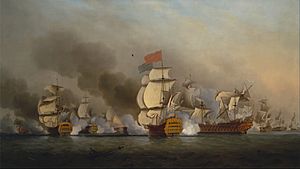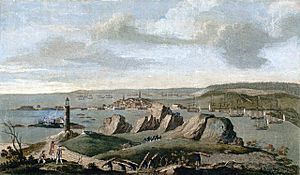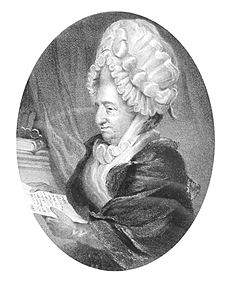Edward Boscawen facts for kids
Quick facts for kids
Edward Boscawen
|
|
|---|---|
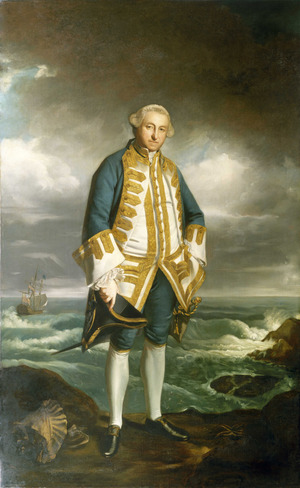
Portrait of Edward Boscawen
by Joshua Reynolds, circa 1825 |
|
| Nickname(s) | Old Dreadnought Wry-necked Dick |
| Born | 19 August 1711 Tregothnan, Cornwall, England |
| Died | 10 January 1761 (aged 49) Hatchlands Park, Surrey, England |
| Buried | |
| Allegiance | |
| Service/ |
|
| Years of service | 1723–1761 |
| Rank | Admiral of the Blue |
| Commands held |
|
| Battles/wars | Anglo-Spanish War (1727–1729) War of Jenkins' Ear War of the Austrian Succession
|
| Relations | Hugh Boscawen, 1st Viscount Falmouth George Boscawen, 2nd Earl of Falmouth George Evelyn Boscawen, 3rd Viscount Falmouth Edward Boscawen, 4th Viscount Falmouth Lieutenant General the Hon. George Boscawen |
Admiral of the Blue Edward Boscawen (born August 19, 1711 – died January 10, 1761) was a famous British admiral in the Royal Navy. He was also a Member of Parliament for Truro, a town in Cornwall, England.
Boscawen is best known for leading important naval battles in the 1700s. He won key victories, like the siege of Louisbourg in 1758 and the Battle of Lagos in 1759. He was also involved in the trial of Admiral John Byng, signing the order for his punishment in 1757.
As a politician, Boscawen served as a Member of Parliament for Truro from 1742 until he died. He was also a member of the Board of Admiralty, which managed the Royal Navy.
Contents
Edward Boscawen was born in Tregothnan, Cornwall, England, on August 19, 1711. He was the third son of Hugh Boscawen, 1st Viscount Falmouth.
Young Edward joined the navy when he was just 12 years old. His first ship was the HMS Superb, which had 60 guns. The Superb sailed to the West Indies during the Anglo-Spanish War (1727–1729). Edward stayed on this ship for three years.
After that, he served on several other ships. In 1732, Boscawen became a lieutenant. He continued to serve in the Mediterranean Sea. By 1736, he was given temporary command of the HMS Leopard. In 1738, he took command of the HMS Shoreham, a smaller ship. He was then ordered to join Admiral Edward Vernon in the West Indies, preparing for a war with Spain.
War of Jenkins' Ear
This war was Boscawen's first chance to see real action. When his ship, Shoreham, was not ready for battle, he volunteered to join Admiral Vernon's fleet. They were sent to attack Porto Bello.
Attacking Porto Bello
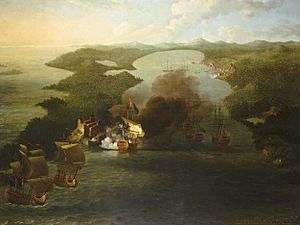
During the attack on Porto Bello, Boscawen was ordered to destroy the forts. This job took three weeks and a lot of gunpowder. The British forces successfully destroyed the forts around the town.
Admiral Vernon's victory was celebrated in Britain. The patriotic song "Rule, Britannia" was played for the first time. Many streets were even named after Porto Bello. When the fleet returned to Port Royal, Jamaica, Boscawen went back to commanding the Shoreham.
The Battle of Cartagena
In 1741, Boscawen was part of a fleet sent to attack another Caribbean port, Cartagena de Indias. Many soldiers were sent from Britain to attack the forts around the Spanish city. The siege lasted over two months. British troops suffered many casualties, mostly from diseases common in the Caribbean.
Even though the British lost this battle, Boscawen proved himself again. The land forces he commanded helped capture Fort San Luis and Boca Chica Castle. He also helped destroy the captured forts when the siege ended. For his bravery, he was promoted to captain in May 1742. He was given command of the 70-gun Prince Frederick.
War of the Austrian Succession
In 1742, Boscawen returned to England on the Prince Frederick. He then joined the fleet under Admiral Norris on the new 60-gun HMS Dreadnought. In the same year, he became a Member of Parliament for Truro. He held this position until his death.
In 1744, the French tried to invade England. Boscawen was with Admiral Norris's fleet when the French ships were spotted. The French fleet retreated, and a big storm stopped the British from attacking them.
While patrolling the English Channel, Boscawen captured a French frigate called Médée. This was the first enemy ship captured by the British in the War of Austrian Succession. The Médée was later sold and became a successful privateer (a privately owned warship) named Boscawen.
In 1745, Boscawen was given command of HMS Namur, a large warship. He was appointed to lead a small group of ships in the Channel.
First Battle of Cape Finisterre
In 1747, Boscawen joined Admiral Anson and played a big part in the First Battle of Cape Finisterre. The British fleet saw the French fleet on May 3. The French fleet was protecting its merchant ships. The British attacked and almost completely destroyed the French fleet. Boscawen was injured in the shoulder during the battle. The French captain, M. de Hocquart, became Boscawen's prisoner for the second time.
Command in India
Boscawen was promoted to rear-admiral of the blue on July 15, 1747. He was then sent to command a joint operation in the East Indies. He sailed from England on November 4, 1747, with his flag on the Namur.
On the way, Boscawen tried to capture Mauritius by surprise, but French forces stopped him. He continued to Fort St. David in India, arriving on July 29, 1748. Boscawen was ordered to capture the main French settlement in India, Pondichéry. However, the attack failed due to Boscawen's lack of experience in land battles and the skill of the French governor.
The British forces did capture an outlying fort, but they could not break through the city walls. They eventually withdrew. Among the soldiers were a young Robert Clive, who later became famous as Clive of India. During the retreat, Major Stringer Lawrence was captured by the French.
During the monsoon season, a storm hit the British outpost. Boscawen was on land, but his flagship Namur sank with over 600 men. Boscawen returned to England in 1750. In 1751, he joined the Admiralty Board, which oversaw the navy. He remained on the Board until his death.
Seven Years' War
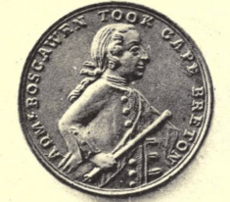
On February 4, 1755, Boscawen was promoted to vice admiral. He was given command of a squadron in North America. He was ordered to stop French ships carrying reinforcements to Canada. On June 8, Boscawen's ships spotted three French ships off Newfoundland. In the battle, the British captured two French ships, the Alcide and the Lys. The third ship escaped. The captain of the Alcide, M. de Hocquart, was captured by Boscawen for the third time!
Boscawen's squadron headed to Halifax to regroup. However, a fever spread through the ships, and Boscawen had to return to England.
Back in England, Boscawen was commander-in-chief at Portsmouth. He was involved in the trial of Admiral John Byng. Boscawen signed the order for Byng's punishment after the King did not pardon him. Boscawen became the Senior Naval Lord on the Admiralty Board in November 1756.
Siege of Louisbourg
On February 7, 1758, Boscawen was promoted to Admiral of the blue squadron. He was ordered to take a fleet to North America. There, he took naval command at the siege of Louisbourg in June and July 1758. This time, the land attack was led by General Jeffrey Amherst and Brigadier James Wolfe.
The capture of Louisbourg was very important for taking French lands in Canada. It removed the only effective French naval base in Canada. Four French warships were destroyed, and another was captured. When Boscawen returned from North America, he received thanks from both Houses of Parliament. The King also made Boscawen a Privy Counsellor for his service.
Battle of Lagos
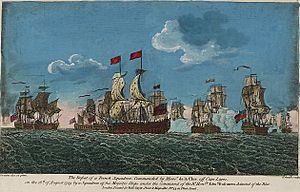
In April 1759, Boscawen took command of a fleet going to the Mediterranean Sea. His goal was to stop another planned invasion of Britain by the French. With his flag on the new 90-gun HMS Namur, he blocked the French fleet in Toulon harbor.
After some fighting and damage to his ships, Boscawen took his fleet to Gibraltar for repairs. On August 17, a British ship signaled that the French fleet was in sight. Boscawen took his ships to sea to engage the French. During the night, the British chased the French fleet. Five French ships managed to escape, but the others were driven into a bay near Lagos, Portugal.
The British caught up with the remaining seven French ships and attacked. The French ship Centaur fought the Namur but was outgunned and surrendered. Damage to the Namur forced Boscawen to move his flag to another ship. While transferring, his small boat was hit by a cannonball. Boscawen quickly used his wig to plug the hole!
Two more French ships escaped during the second night. On the morning of August 19, the British captured two French ships. The French flagship and another ship were driven ashore, where their crews set them on fire to prevent the British from taking them. The five French ships that escaped went to Cadiz, where Boscawen ordered them to be blockaded.
Final Years and Legacy
Boscawen returned to England and was promoted to General of Marines. He was also given the Freedom of the City of Edinburgh. Admiral Boscawen went to sea one last time, stationed off the west coast of France.
After a severe illness, later thought to be Typhoid fever, the Admiral came ashore. He died on January 10, 1761, at his home in Hatchlands Park in Surrey. He was buried at St. Michael's Church in St Michael Penkevil, Cornwall. His monument there reads:
Edward Boscawen,
Admiral of the Blue, General of Marines,
Lord of the Admiralty, and one of his
Majesty's most Honourable Privy Council.
His birth, though noble,
His titles, though illustrious,
Were but incidental additions to his greatness.
William Pitt, 1st Earl of Chatham, who was Prime Minister, once said about Boscawen: "When I apply to other Officers respecting any expedition I may chance to project, they always raise difficulties, you always find expedients." This shows how good Boscawen was at finding solutions.
Legacy
The town of Boscawen, New Hampshire in the United States is named after him. The Royal Navy has also named two ships and a training base, HMS Boscawen, after Admiral Boscawen.
Famous Quotes
Edward Boscawen was known for saying:
- "To be sure I lose the fruits of the earth, but then, I am gathering the flowers of the Sea" (1756).
- "Never fire, my lads, till you see the whites of the Frenchmen's eyes."
Frances Evelyn Boscawen
In 1742, Boscawen married Frances Evelyn Glanville (1719–1805). They had three sons and two daughters. After his death, Frances became an important hostess of "Bluestocking" meetings, which were gatherings for intellectual women. Their older daughter, Frances, married John Leveson-Gower. Their younger daughter, Elizabeth, married Henry Somerset, 5th Duke of Beaufort.
Images for kids
-
The bombardment of Porto Bello, by Samuel Scott
-
The Battle of Lagos, 1759, by Francis Swaine
See also
 In Spanish: Edward Boscawen para niños
In Spanish: Edward Boscawen para niños



